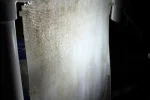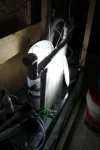Low-light Scrubbers
Here is something new, different, and untested. I have not built one yet, but it should work for either SW or FW if the size and flow are correct. It is a vertical scrubber that you hang on the wall, and it requires NO electricity. It is a "low-light" scrubber:
I got the idea when reading a study about algae growth in freshwater streams:
"Algal Response to Nutrient Enrichment In Forested Oligotrophic Streams". Journal of Phycology, June 2008.
ALGAL RESPONSE TO NUTRIENT ENRICHMENT IN FORESTED OLIGOTROPHIC STREAM1 - Veraart - 2008 - Journal of Phycology - Wiley Online Library
"Algae inhabiting forested streams have the capacity to acclimate to low light intensity. These light conditions affect their photosynthetic efficiency, but do not impair growth rates, in particular, in the case of thin diatom-dominated communities."
In other words, they don't filter as much per square inch (or per square cm) of area, but they do operate on very low light. Apparently it is mostly diatoms that grow in these low-light conditions.
The advantage of a scrubber like this should be obvious: It requires no electricity to power the screen. It still requires a pump, however, since the top of the scrubber would (probably) be high above the top of the tank. The scrubber is designed to operate on the light already available in the room, which would vary greatly depending on how strong the light bulbs are in the room, and how much sunlight comes in through the windows. The more average light the room has, the smaller the scrubber can be. The less light, the bigger it needs to be. Basically, the scrubber uses more area to make up for less light. And since the light is so low, the type of algae that is able to survive is (apparently) mostly diatoms.
Just as with regular scrubbers, the wider the unit it, the more flow is required. So in the spirit of keeping it from consuming too much electricty, a smaller pump could be used if the unit were narrow and tall. But the bottom of the unit will need to drain into either the tank or the sump, so there will be a limit to how low the bottom can be. And the limit to the top will be the ceiling. A tradeoff will need to be made, maybe so that it looks like a vertical picture on the wall. Fortunately the flow does not need to be as much as a regular scrubber, since it is one-sided only.
It will have to be experimented with to see if a clear cover is needed to stop any water dropletts from splashing out. Many people have decorative waterfalls of the same size as these, and they have no cover on them, so maybe water dropletts getting on the floor will not happen. Evaporation would be high though, and this might be reason enough to consider a clear cover.
Cleaning could (apparently) be done by having a removeable screen or porous sheet, just like a regular scrubber has. It would be big though, and would drip as you took it out. Also it probably would not fit into a sink, and so would need a bathtub or shower (or outside) for cleaning. A possible fix for this might be a very flexibe woven plastic mesh, which you could fold up like a towell and easily clean in a sink. A material like this might not lay down flat when it's in the scrubber, however.
This type of scrubber would be easiest to try for somebody with a cement floor, lots of wall space, open widows or skylights, a low sump, high ceilings, and a big sink or patio for cleaning. I have no idea of the size required for the unit.



